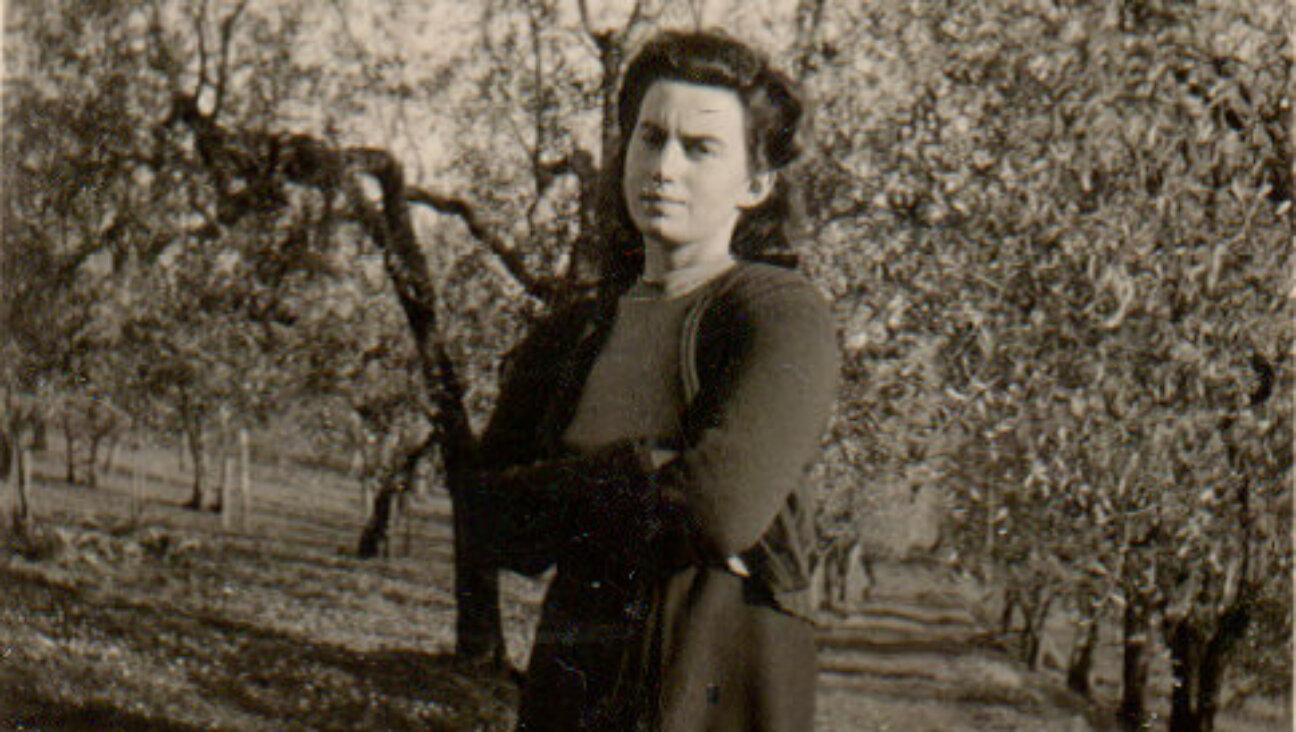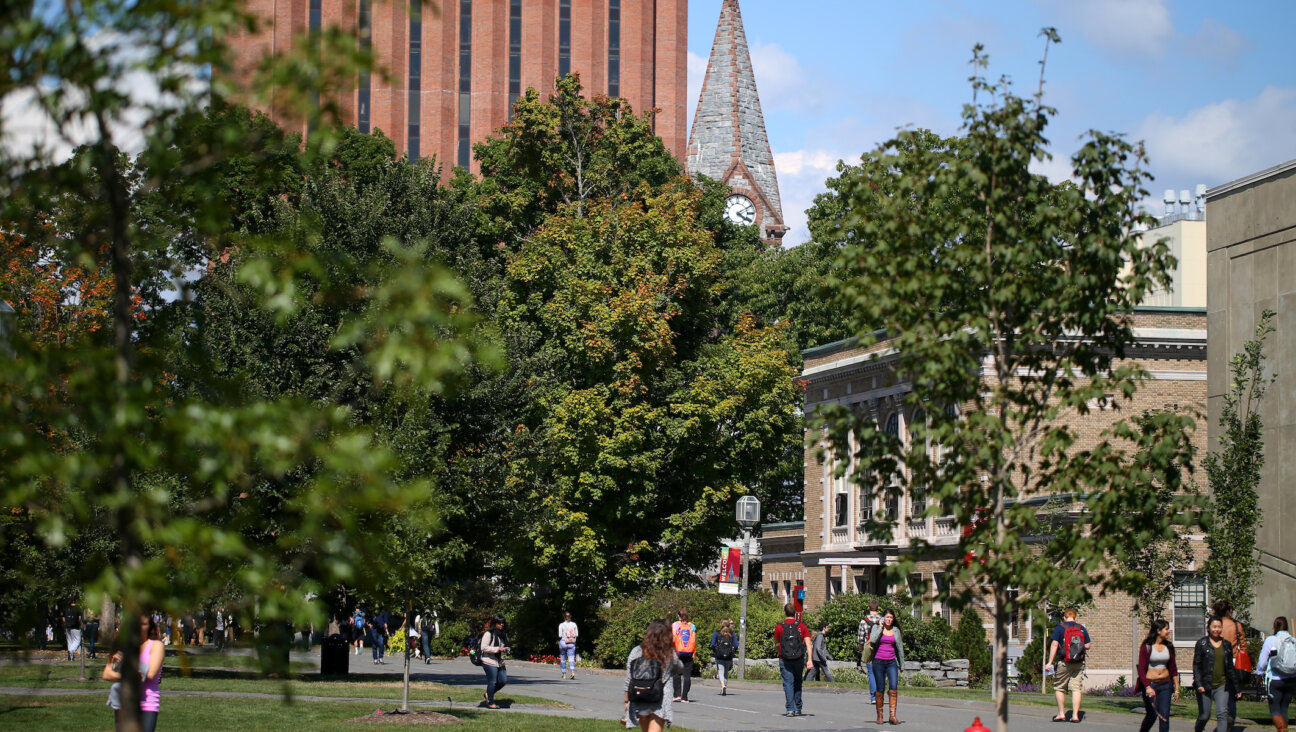Wrapping Their Feet Around the Music
‘Klezmer dancing? It’s not really a sitting and listening kind of music; it’s a moving kind of music,” said Amy Zakar, one of the young fiddlers at the eighth annual KlezKanada Festival of Yiddish/Jewish Music and Culture, held August 19 through August 25 at Camp B’nai Brith, in the woods north of Montreal. “I just try to put away my fiddle before I get swept into it,” Zakar said.
This year, along with workshops and lectures in instrumental performance and composition, literature and theater, amulet making and cooking, KlezKanada offered an expanded curriculum in Yiddish dance. So every day at 10:45 a.m., groups met under the leadership of Michael Alpert and Walter “Zev” Feldman, two of the world’s best-known klezmer-dance figures. Both men are professional musicians and musicologists who combine direct childhood experience of the dance tradition with considerable professional expertise in other folk-dance traditions. And both dance with zest and talk about dancing with considerable earnestness.
When Alpert yanks out his white tikhl (handkerchief) and flourishes it over his head, it is a signal that the dance is about to begin. He is tall, thin, usually dressed in black, and moves with grace and what seems like limitless energy. Wherever he is, people follow his lead in the dance. Alpert is a co-director of KlezKanada, a pioneer of the klezmer renaissance best known for his fiddling with such groups as Brave Old World and Khevrisa, and he dances with great precision. He is particularly mindful of the etiquette of dance: the eye contact and body signals that make it a social form for couples as well as groups.
Feldman, like Alpert, is American-born and saw Jewish Bessarabian dancing when he was young. Moving with elegant control, he demonstrated not only men’s style, with its fancy footwork, but also women’s style — leading with the shoulders. He explained how Jewish dance forms differ from the Balkan and Eastern European versions. For instance, Jewish dance culture emphasizes respect for age — so sprightliness and restraint are emphasized rather than strength. He is keenly aware that for a generation there were no klezmer musicians who knew how to play for dancing, which is an art in itself. “My mission,” Feldman said, “is to popularize this dancing, to help people find themselves in the movement and enjoy it.”
Everyone at KlezKanada understood this was a rare opportunity. Where else can one go to learn Yiddish dance? There are not many people left who remember from their youth the shers, the broyges tants and other traditional dances and can still demonstrate the tricky moves, the hand gestures and the stamps. Helen Winkler, a recreational folk-dance teacher, came to klezmer dance by way of Israeli dance. She even maintains a Web site called Helen’s Yiddish Dance Page (www.angelfire.com/ns/helenwinkler), but pointed out ruefully, “It’s hard to learn style on the Internet.” Steve Weintraub, who already teaches dance at KlezKamp and the Circle Lodge, wanted to see more dances and “get them into my body. Once you have a good grounding in the traditional patterns,” he explained, “then you can feel free to improvise.”
Violinist Deborah Strauss, of the Strauss/Warschauer Duo, was particularly glad to play for the dance classes. “You can’t divide the music from the dance,” she said. “I always have my students dance at lessons. To wrap my feet around the steps and feel where the pulse is, where it’s strong and where it lifts, the phrasing, the tempo — it all makes me a better musician.” In fact, in the course of the dance classes, she tended to wander away from the band toward the dancers, and while her arms kept fiddling, her feet moved along with the dance. “It’s hard to stand still. The whole cultural context — it all ties together in this beautiful tangle,” she said.
Four hundred people attended KlezKanada this year, and at one time or other almost everybody danced. The most concentrated time occurred at night after the staff and student concerts in the gym, when the chairs got cleared out of the way and what Weintraub calls the “wild nighttime” feeling, the freylekh feeling, took over. The white tikhl came out and fluttered overhead; circles and lines formed and re-formed; people who had attended the classes danced with people who just liked moving to music. Lines bunched up, broke off and went in counterdirections. Elderly people danced with teenagers. The shyest felt free to enter a line. People parted hands to invite a stranger in. “The dancing,” singer Inna Barmash said, “doesn’t just illuminate the music. It’s all about relationships, forming relationships on the dance floor. And playing.”
There were other dance times built into KlezKanada traditions. One was the “backward procession” modeled on a Friday night tradition of the chasidic community of Safed in Israel. To greet the Sabbath queen, the people of Safed would go with musicians to the Western edge of town, toward the sunset, and escort “her” to the synagogue, walking backward to show respect for royalty. At KlezKanada, everyone goes to the lake and walks backward to the dining hall, where they enjoy a festive Sabbath dinner. Only they not only walk; they dance.
Alpert’s high point for dancing came the last night of the festival. The concert was over at 2 a.m., and people were so eager to dance that the chairs were cleared and people were on the floor dancing before the last set of musicians took their final bows. The energy rose higher and higher. The band was playing the strongly accented dance called the bulgar. Alpert recalls that he looked around and thought to himself, “This is the best bulgar that has ever happened here. Everybody was rocking out in a Jewish way. They knew what to do. They were loving the movement, loving being together. It was a consummate social moment and a consummate dance moment.”
Three hours later, after the nightly late-hours “klezcabaret,” the traditional die-hards drifted out to the lakeside to serenade the chilly sunrise. There too, singing chasidic nigunim and swaying with the last of their energy, they danced “to keep each other warm.”
Inspired by the week’s dancing, Hy Goldman, KlezKanada’s founder and motivating force, plans to expand the dance program for next summer’s gathering.
William Meyers is a photographer and writer. Work from his project “Outer Boroughs: New York Beyond Manhattan” can be seen at www.wmmeyers.com.
The Forward is free to read, but it isn’t free to produce

I hope you appreciated this article. Before you go, I’d like to ask you to please support the Forward.
Now more than ever, American Jews need independent news they can trust, with reporting driven by truth, not ideology. We serve you, not any ideological agenda.
At a time when other newsrooms are closing or cutting back, the Forward has removed its paywall and invested additional resources to report on the ground from Israel and around the U.S. on the impact of the war, rising antisemitism and polarized discourse.
This is a great time to support independent Jewish journalism you rely on. Make a gift today!
— Rachel Fishman Feddersen, Publisher and CEO
Support our mission to tell the Jewish story fully and fairly.
Most Popular
- 1

Fast Forward Ye debuts ‘Heil Hitler’ music video that includes a sample of a Hitler speech
- 2

Opinion It looks like Israel totally underestimated Trump
- 3

Culture Cardinals are Catholic, not Jewish — so why do they all wear yarmulkes?
- 4

Fast Forward Student suspended for ‘F— the Jews’ video defends himself on antisemitic podcast
In Case You Missed It
-

Culture How one Jewish woman fought the Nazis — and helped found a new Italian republic
-

Opinion It looks like Israel totally underestimated Trump
-

Fast Forward Betar ‘almost exclusively triggered’ former student’s detention, judge says
-

Fast Forward ‘Honey, he’s had enough of you’: Trump’s Middle East moves increasingly appear to sideline Israel
-
Shop the Forward Store
100% of profits support our journalism
Republish This Story
Please read before republishing
We’re happy to make this story available to republish for free, unless it originated with JTA, Haaretz or another publication (as indicated on the article) and as long as you follow our guidelines.
You must comply with the following:
- Credit the Forward
- Retain our pixel
- Preserve our canonical link in Google search
- Add a noindex tag in Google search
See our full guidelines for more information, and this guide for detail about canonical URLs.
To republish, copy the HTML by clicking on the yellow button to the right; it includes our tracking pixel, all paragraph styles and hyperlinks, the author byline and credit to the Forward. It does not include images; to avoid copyright violations, you must add them manually, following our guidelines. Please email us at [email protected], subject line “republish,” with any questions or to let us know what stories you’re picking up.















